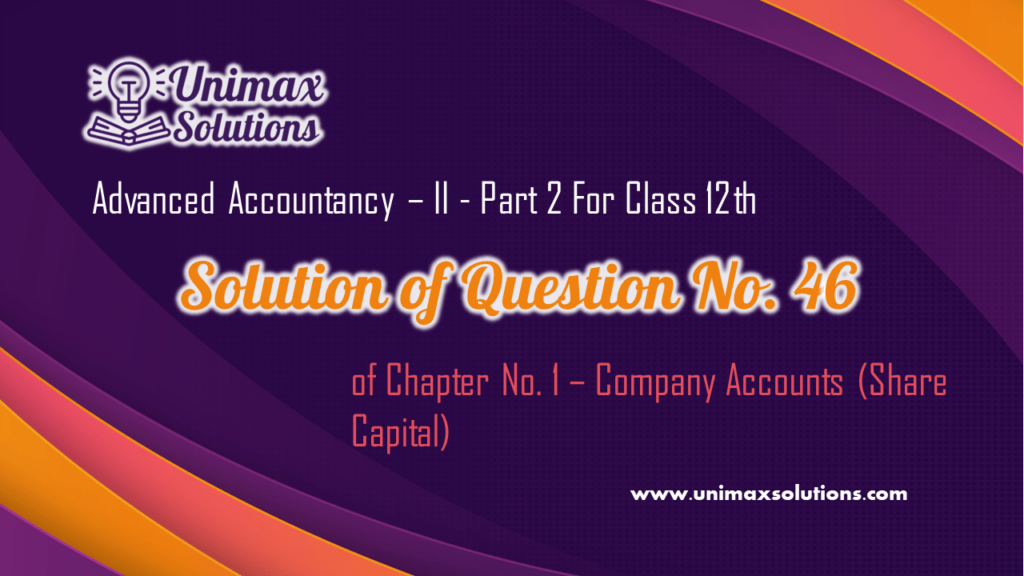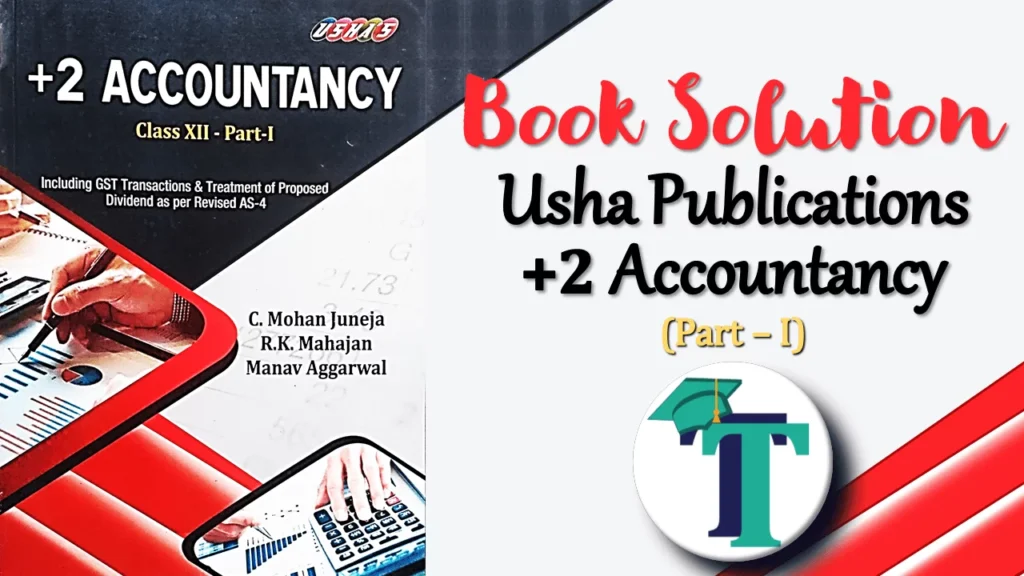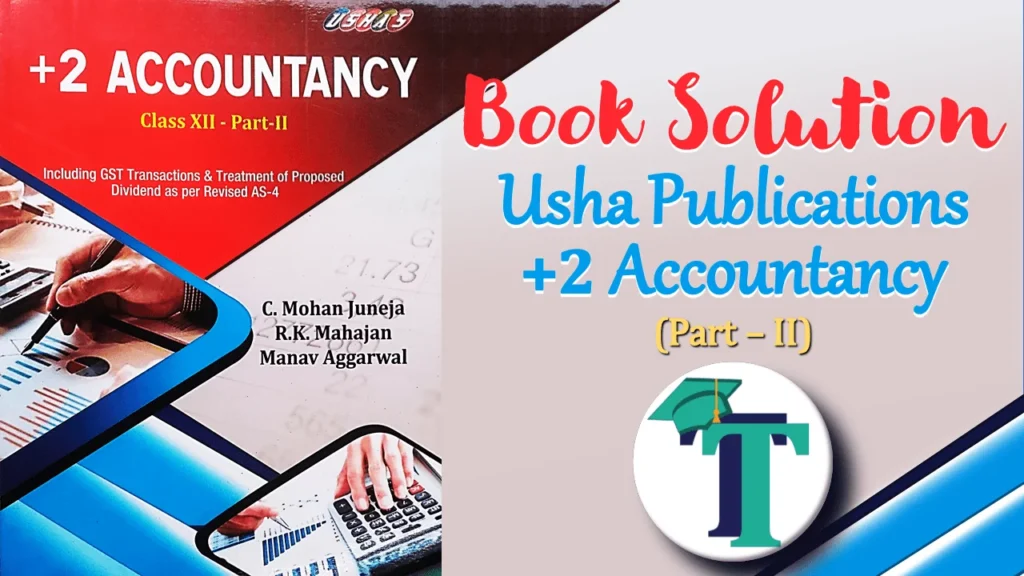
Advertisement
Question No 46 Chapter 1 – Unimax Class 12 Part 2 – 2021
ABC Ltd. forfeited 150 equity shares of ₹10 each issued at a premium of ₹ 5 per share, for non-payment of allotment money of ₹ 8 per share (including premium of ₹ 5 pr share), the first call of ₹ 2 per share and the final call of ₹ 3 per share. Out of these, 100 equity shares were reissued at ₹ 14 pre share. Given journal entries in the books of the company to record the forfeited and reissued of shares
The solution of Question no 46 Chapter 1- Class 12 Part 2 Unimax: –
In the books of M/S ABC Ltd.
Journal entries
| Date | Particulars | L.F. | Debit | Credit | |
| Equity Shares capital A/c | Dr. | 1,500 | |||
| Securities Premium A/c | Dr. | 750 | |||
| To Equity Shares Allotment A/c | 1,200 | ||||
| To Equity shares forfeited A/c | 300 | ||||
| To Equity share first call A/c | 300 | ||||
| To Equity share final call A/c | 450 | ||||
| (Being 150 equity shares forfeited due to non-payment. First call and final call money) | |||||
| Bank A/c | Dr. | 1,400 | |||
| To Equity share capital A/c | 1,000 | ||||
| To Securities Premium A/c | 400 | ||||
| (Being 100 forfeited equity shares reissued to each, fully paid up ₹ 14 per share) | |||||
| Shares forfeited A/c | Dr. | 200 | |||
| To Capital reserve A/c | 200 | ||||
| (Being profit on 200 forfeited shares transferred to capital reserve) | |||||
Working Note:
1. Calculation of Application money
| ₹ | |
| Face value of share | 10 |
| Less: First and final call money | 5/5 |
| Less: Allotment money excluding premium (8-5) | 3 |
| Application money received and forfeited per share | 2 |
2. Calculate of Amount Transferred to Capital Reserve
| ₹ | |
| Amount forfeited on 150 shares | = ₹300 |
Amount forfeited on 100 shares | = 300/150 X 100 = ₹200 |
| Less: Discount allowed on reissued shares | = Nil |
| Balance credited to capital reserve A/c | =₹ 200 |
3. Since, share premium remains unpaid, securities A/c has been debited at the time of forfeiture of shares.
4. Shares, if originally issued at premium and forfeited need not to be issued at original premium.
Advertisement
End of Solution
Check Out the Solution of all questions for this chapter:
The solution to all questions of Chapter No. 1 – Company Accounts (Share Capital) Class 12 Unimax is shown as follows, click on the image of the question to get the solution.
Question no 3 Chapter 1 – Class 12 Part 2 Unimax
Advertisement
Question No 8 Chapter 1 – Class 12 Part 2 Unimax
Advertisement
Check out all books for PSEB
1. Comprehensive Solutions for All Chapters of Advanced Accountancy Part 1 Class 12 by Unimax
UnimaxSolutions.in offers a comprehensive solution for students studying Advanced Accountancy Part 1 in Class 12. With their meticulously curated study material, students can access comprehensive solutions to all the questions in each chapter. By selecting the chapter name from the study material, students can easily navigate through the topics and find detailed explanations and step-by-step solutions to the problems presented in that section. Whether it’s understanding complex accounting concepts, mastering calculation techniques, or analyzing financial statements, Unimax provides a valuable resource to aid students in their learning journey. With these comprehensive solutions at their disposal, students can enhance their understanding, clarify doubts, and improve their problem-solving skills in Advanced Accountancy, ensuring they are well-prepared for their Class 12 examinations.
- Chapter No. 1 – Accounts of Non-Profit Organisations
- Chapter No. 2 – Partnership Accounts – I (Basic Concepts)
- Chapter No. 3 – Partnership Accounts – II (Goodwill)
- Chapter No. 4 – Partnership Accounts – III (Change in Profit Sharing Ratio among Existing Partners)
- Chapter No. 5 – Partnership Accounts – IV (Admission of A Partner)
- Chapter No. 6 – Partnership Accounts – V (Retirement and Death of A Partner)
- Chapter No. 7 – Partnership Accounts – VI (Dissolution of Partnership Firm)
2. Comprehensive Solutions for All Chapters of Advanced Accountancy Part 2 Class 12 by Unimax
UnimaxSolutions.in presents an exceptional resource for students studying Advanced Accountancy Part 2 in Class 12. With their comprehensive study material, students can conveniently access extensive solutions to all the questions in each chapter. By simply selecting the desired chapter from the study material, students can effortlessly navigate through the topics and gain access to detailed explanations and step-by-step solutions to every problem presented in that particular section. Whether it involves understanding intricate accounting principles, honing calculation techniques, or analyzing complex financial statements, Unimax provides a valuable tool to support students in their learning journey. Equipped with these comprehensive solutions, students can enhance their comprehension, resolve any uncertainties, and strengthen their problem-solving abilities in Advanced Accountancy, empowering them to excel in their Class 12 examinations with confidence.
- Chapter No. 1 – Company Accounts (Share Capital)
- Chapter No. 2 – Issue of Debentures
- Chapter No. 3 – Redemption of Debentures
- Chapter No. 4 – Financial Statements of a Company (Balance Sheet Only)
- Chapter No. 5 -Financial Statement Analysis
- Chapter No. 6 – Tools/Methods of Financial Analysis
- Chapter No. 7 – Ratio Analysis
- Chapter No. 8 – Cash Flow Statement
Punjab School Education Board (PSEB) Solutions of Usha Publication.
If you’re a student enrolled in the Punjab School Education Board Class 12, exploring a wide range of books to cover the syllabus thoroughly is essential. While the prescribed textbooks are undoubtedly valuable, supplementing your studies with additional resources can enhance your understanding and knowledge. Consider checking out other books that align with the curriculum, offering different perspectives and insights on the subjects you’re studying. These supplementary materials can provide you with alternative explanations, practice questions, and examples that may aid in clarifying complex concepts. Moreover, exploring diverse sources can expose you to various writing styles and viewpoints, fostering a broader understanding of the subjects. So, seize the opportunity to expand your learning by delving into other books that can complement your studies and contribute to your academic growth.
Advertisement


